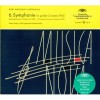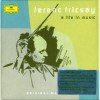Composers
Karl Amadeus Hartmann (2 August 1905 – 5 December 1963) was a German composer. Some] have lauded him as the greatest German symphonist of the 20th century, although he is now largely overlooked, particularly in English-speaking countries.
Born in Munich, the son of Friedrich Richard Hartmann, well known there for his flower paintings, and the youngest of four brothers of whom the elder three also became painters, Hartmann was himself torn, early in his career, between music and the visual arts. He was much affected in his early political development by the events of the unsuccessful Workers’ Revolution in Bavaria that followed the collapse of the German monarchy at the end of World War I (see Bavarian Soviet Republic), and he remained an idealistic socialist all his life.
At the Munich Academy in the 1920s Hartmann studied with Joseph Haas, a pupil of Max Reger, and later he received enormous intellectual stimulus and encouragement from the conductor Hermann Scherchen, an ally of the Schoenberg school, with whom he had a nearly lifelong mentor-protégé relationship. He voluntarily withdrew completely from musical life in Germany during the Nazi era, while remaining in Germany, and refused to allow his works to be played there. An early symphonic poem, Miserae (1933–1934, first performed in Prague, 1935) was condemned by the Nazi regime; but his work continued to be performed, and his fame grew, abroad.
During World War II, though already an experienced composer, Hartmann submitted to a course of private tuition in Vienna by Schoenberg’s pupil Anton Webern (with whom he often disagreed on a personal and political level). Although stylistically their music had little in common, he clearly felt that he needed, and benefitted from, Webern’s acute perfectionism.
After the fall of Hitler, Hartmann was one of the few prominent surviving anti-fascists in Bavaria whom the postwar Allied administration could appoint to a position of responsibility. In 1945, he became a Dramaturg at the Bavarian State Opera and there, as one of the few internationally-recognized figures who had survived untainted by any collaboration with the Nazi regime, he became a vital figure in the rebuilding of (West) German musical life. Perhaps his most notable achievement was the Musica Viva concert series which he founded and ran for the rest of his life in Munich. Beginning in November 1945, the concerts reintroduced the German public to 20th-century repertoire which had been banned since 1933 under National Socialist aesthetic policy. Hartmann also provided a platform for the music of the young composers who came to the fore in the late 1940s and early 1950s, helping to establish such figures as Hans Werner Henze, Luigi Nono, Luigi Dallapiccola, Carl Orff, Iannis Xenakis, Olivier Messiaen, Luciano Berio, Bernd Alois Zimmermann and many others. Hartmann also involved sculptors and artists such as Jean Cocteau, Le Corbusier, and Joan Miró in exhibitions at Musica Viva.
He was accorded numerous honours after the war, including the Musikpreis of the city of Munich in March 1949. This was followed by the Kunstpreis of the Bayrische Akademie der Schönen Künste (1950), the Arnold Schönberg Medal of the IGNM (1954), the Große Kunstpreis of the Land Nordrhein-Westfalen (1957), as well as the Ludwig Spohr Award of the city of Braunschweig, the Schwabing Kunstpreis (1961) and the Bavarian Medal of Merit (1959). In addition, Hartmann became a member of the Academy of Arts in Munich (1952) and Berlin (1955) and received an honorary doctorate from Spokane Conservatory, Washington (1962). It should be noted that his socialist sympathies did not at all include communism: in the 1950s he refused an offer to move to East Germany
He continued to base his activities in Munich for the remainder of his life, and his administrative duties came to absorb much of his time and energy. This reduced his opportunities for composition, and his last years were dogged by serious illness. In 1963, he died from stomach cancer at the age of 58, leaving his last work – an extended symphonic Gesangsszene for voice and orchestra on words from Jean Giraudoux’s apocalyptic drama Sodom and Gomorrah – unfinished.
Significantly, no major German conductor championed his music following his death: Scherchen, his most noted advocate, died in 1966. Some have suggested that this accelerated the disappearance of Hartmann's music from public view in the years following his death.[1] The Czech Rafael Kubelik was one notable figure who regularly performed Hartmann's music, as did Ferdinand Leitner who also recorded Symphonies #3 and #6.[2] In recent years conductors such as Ingo Metzmacher and Mariss Jansons have brought many works back into the concert hall.
Hartmann completed a number of fine works, most notably eight symphonies. The first of these, and perhaps emblematic of the difficult genesis of many of his works, is Symphony No. 1, titled "Essay for a requiem" (Versuch eines Requiems). This work began in 1936 as a cantata for alto solo and orchestra, loosely based on a few select poems by Walt Whitman. It soon became known as "Our Life: Symphonic Fragment" (Unser Leben: Symphonisches Fragment) and was intended as a comment on the generally miserable conditions for artists and liberal minded individuals under the early Nazi regime. After the defeat of the Third Reich in World War II, the real victims of the regime had become clear, and the cantata's title was changed to "Symphonic Fragment: Attempt at a Requiem" to honor the millions killed in the Holocaust. Hartmann revised the work in 1954-1955 as his Symphony No. 1, and finally published it in 1956. As this example indicates, Hartmann was a highly self-critical composer and many of his works went through successive stages of revision. He also suppressed most of his substantial orchestral works of the late 1930s and the war years, either allowing them to remain unpublished or, in several cases, reworking them - or portions of them - into the series of numbered symphonies that he produced in the late 1940s and early 1950s. Perhaps the most frequently-performed of his symphonies are No. 4, for strings, and No. 6; probably his most widely-known work, through performances and recordings, is his Concerto funebre for violin and strings, composed at the beginning of World War II and making use of a Hussite chorale and a Russian revolutionary song of 1905.
As a composer, Hartmann attempted a difficult synthesis of many different idioms, including musical Expressionism and jazz stylization, into organic symphonic forms in the tradition of Bruckner and Mahler. His early works contain music that is both satirical and politically engaged. But he admired the polyphonic mastery of J.S. Bach, the profound expressive irony of Mahler, the neoclassicism of Igor Stravinsky and Paul Hindemith. He, also in the 1930s, developed close ties with Béla Bartók and Zoltán Kodály in Hungary, and this is reflected in his own music to some extent. In the 1940s, he began to take an interest in Schoenbergian Twelve-tone technique; though he studied with Webern his own idiom was closer to Alban Berg. In the 1950s, Hartmann started to explore the metrical techniques pioneered by Boris Blacher and Elliott Carter. He especially makes use of the forms of three-part Adagio slow movements, Fugue, Variations and Toccata.
Recently Added
Biography
Karl Amadeus Hartmann (2 August 1905 – 5 December 1963) was a German composer. Some] have lauded him as the greatest German symphonist of the 20th century, although he is now largely overlooked, particularly in English-speaking countries.
Born in Munich, the son of Friedrich Richard Hartmann, well known there for his flower paintings, and the youngest of four brothers of whom the elder three also became painters, Hartmann was himself torn, early in his career, between music and the visual arts. He was much affected in his early political development by the events of the unsuccessful Workers’ Revolution in Bavaria that followed the collapse of the German monarchy at the end of World War I (see Bavarian Soviet Republic), and he remained an idealistic socialist all his life.
At the Munich Academy in the 1920s Hartmann studied with Joseph Haas, a pupil of Max Reger, and later he received enormous intellectual stimulus and encouragement from the conductor Hermann Scherchen, an ally of the Schoenberg school, with whom he had a nearly lifelong mentor-protégé relationship. He voluntarily withdrew completely from musical life in Germany during the Nazi era, while remaining in Germany, and refused to allow his works to be played there. An early symphonic poem, Miserae (1933–1934, first performed in Prague, 1935) was condemned by the Nazi regime; but his work continued to be performed, and his fame grew, abroad.
During World War II, though already an experienced composer, Hartmann submitted to a course of private tuition in Vienna by Schoenberg’s pupil Anton Webern (with whom he often disagreed on a personal and political level). Although stylistically their music had little in common, he clearly felt that he needed, and benefitted from, Webern’s acute perfectionism.
After the fall of Hitler, Hartmann was one of the few prominent surviving anti-fascists in Bavaria whom the postwar Allied administration could appoint to a position of responsibility. In 1945, he became a Dramaturg at the Bavarian State Opera and there, as one of the few internationally-recognized figures who had survived untainted by any collaboration with the Nazi regime, he became a vital figure in the rebuilding of (West) German musical life. Perhaps his most notable achievement was the Musica Viva concert series which he founded and ran for the rest of his life in Munich. Beginning in November 1945, the concerts reintroduced the German public to 20th-century repertoire which had been banned since 1933 under National Socialist aesthetic policy. Hartmann also provided a platform for the music of the young composers who came to the fore in the late 1940s and early 1950s, helping to establish such figures as Hans Werner Henze, Luigi Nono, Luigi Dallapiccola, Carl Orff, Iannis Xenakis, Olivier Messiaen, Luciano Berio, Bernd Alois Zimmermann and many others. Hartmann also involved sculptors and artists such as Jean Cocteau, Le Corbusier, and Joan Miró in exhibitions at Musica Viva.
He was accorded numerous honours after the war, including the Musikpreis of the city of Munich in March 1949. This was followed by the Kunstpreis of the Bayrische Akademie der Schönen Künste (1950), the Arnold Schönberg Medal of the IGNM (1954), the Große Kunstpreis of the Land Nordrhein-Westfalen (1957), as well as the Ludwig Spohr Award of the city of Braunschweig, the Schwabing Kunstpreis (1961) and the Bavarian Medal of Merit (1959). In addition, Hartmann became a member of the Academy of Arts in Munich (1952) and Berlin (1955) and received an honorary doctorate from Spokane Conservatory, Washington (1962). It should be noted that his socialist sympathies did not at all include communism: in the 1950s he refused an offer to move to East Germany
He continued to base his activities in Munich for the remainder of his life, and his administrative duties came to absorb much of his time and energy. This reduced his opportunities for composition, and his last years were dogged by serious illness. In 1963, he died from stomach cancer at the age of 58, leaving his last work – an extended symphonic Gesangsszene for voice and orchestra on words from Jean Giraudoux’s apocalyptic drama Sodom and Gomorrah – unfinished.
Significantly, no major German conductor championed his music following his death: Scherchen, his most noted advocate, died in 1966. Some have suggested that this accelerated the disappearance of Hartmann's music from public view in the years following his death.[1] The Czech Rafael Kubelik was one notable figure who regularly performed Hartmann's music, as did Ferdinand Leitner who also recorded Symphonies #3 and #6.[2] In recent years conductors such as Ingo Metzmacher and Mariss Jansons have brought many works back into the concert hall.
Hartmann completed a number of fine works, most notably eight symphonies. The first of these, and perhaps emblematic of the difficult genesis of many of his works, is Symphony No. 1, titled "Essay for a requiem" (Versuch eines Requiems). This work began in 1936 as a cantata for alto solo and orchestra, loosely based on a few select poems by Walt Whitman. It soon became known as "Our Life: Symphonic Fragment" (Unser Leben: Symphonisches Fragment) and was intended as a comment on the generally miserable conditions for artists and liberal minded individuals under the early Nazi regime. After the defeat of the Third Reich in World War II, the real victims of the regime had become clear, and the cantata's title was changed to "Symphonic Fragment: Attempt at a Requiem" to honor the millions killed in the Holocaust. Hartmann revised the work in 1954-1955 as his Symphony No. 1, and finally published it in 1956. As this example indicates, Hartmann was a highly self-critical composer and many of his works went through successive stages of revision. He also suppressed most of his substantial orchestral works of the late 1930s and the war years, either allowing them to remain unpublished or, in several cases, reworking them - or portions of them - into the series of numbered symphonies that he produced in the late 1940s and early 1950s. Perhaps the most frequently-performed of his symphonies are No. 4, for strings, and No. 6; probably his most widely-known work, through performances and recordings, is his Concerto funebre for violin and strings, composed at the beginning of World War II and making use of a Hussite chorale and a Russian revolutionary song of 1905.
As a composer, Hartmann attempted a difficult synthesis of many different idioms, including musical Expressionism and jazz stylization, into organic symphonic forms in the tradition of Bruckner and Mahler. His early works contain music that is both satirical and politically engaged. But he admired the polyphonic mastery of J.S. Bach, the profound expressive irony of Mahler, the neoclassicism of Igor Stravinsky and Paul Hindemith. He, also in the 1930s, developed close ties with Béla Bartók and Zoltán Kodály in Hungary, and this is reflected in his own music to some extent. In the 1940s, he began to take an interest in Schoenbergian Twelve-tone technique; though he studied with Webern his own idiom was closer to Alban Berg. In the 1950s, Hartmann started to explore the metrical techniques pioneered by Boris Blacher and Elliott Carter. He especially makes use of the forms of three-part Adagio slow movements, Fugue, Variations and Toccata.

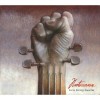
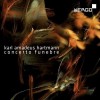
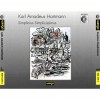


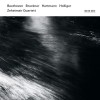
![Rafael Kubelik Rare Recordings 1963-1974 [CD5of8]](http://static.classicalm.com/repository/disk-cover/small/3598-img1404743379219477.jpg)
